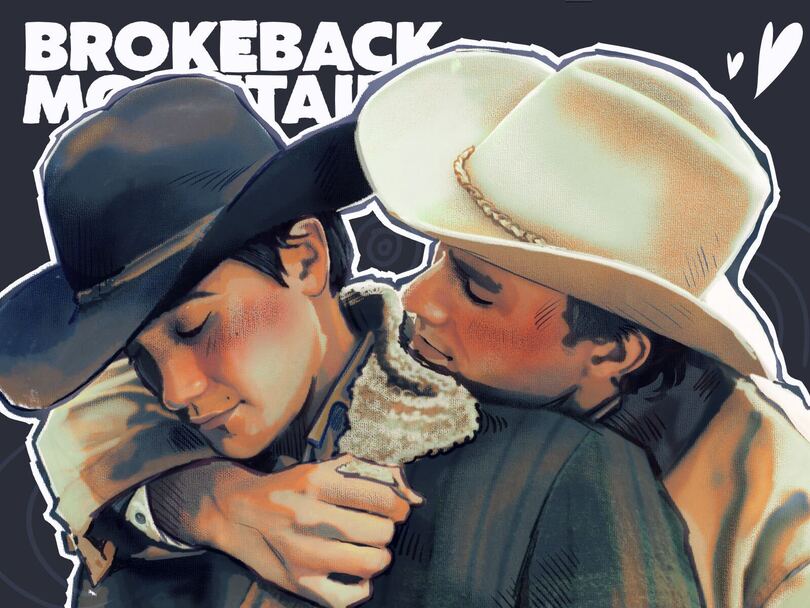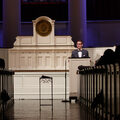‘Brokeback Mountain’ remains timely reminder of LGBTQ+ progress made, needed

Since its release in 2005, “Brokeback Mountain” has been a spark in the fire of LGBTQ+ media. The “gay cowboy movie” is unapologetically tragic and set a precedent for storytelling that was once unimaginable. Jalyn Cronkrite | Contributing Illustrator
Get the latest Syracuse news delivered right to your inbox.
Subscribe to our newsletter here.
Elder Allan Russell of the Emmanuel Apostolic Church called it an attempt to “indoctrinate the world to a most sinful act.” The Guardian’s Rick Moody called it a “sorrowful portrait of a love that truly can’t be spoken of.” A 2006 Syracuse University student called it “a rollercoaster of emotions.” Four United States presidential administrations and 20 years later, I call it necessary.
“Brokeback Mountain” returned to select theaters across the U.S. this month, with special showings throughout June to celebrate the 20th anniversary of the landmark film. The re-release was accompanied by a new film poster, merchandise and other connected initiatives from one of its production companies, Focus Features.
Although Pride Month wasn’t as widely celebrated at the time of its release, the reissue comes just in time to close out the month of June. With recent moves to cut funding to suicide prevention services for LGBTQ+ youth, the rerelease is a reminder of the progress made and still needed.
Directed by Ang Lee and based on the short story by Annie Proulx published in The New Yorker, the film tells the story of a tragic love affair that unfolds between two young shepherds in the summer of 1963. Although Lee “didn’t intend to make a statement with ‘Brokeback Mountain,’” its impact led to its selection as one of 25 films preserved by The National Film Registry in the Library of Congress in 2018.
When the film was originally released in 2005, the U.S. was neck-deep in debates about same-sex marriage. In just the year prior, voters in 13 states passed referenda prohibiting gay marriage. “Don’t Ask, Don’t Tell” wouldn’t be repealed for another five years. A love story between two gay cowboys against a backdrop of rural, Western America was a revolutionary idea at the time, especially for those who thought gay people only existed on Broadway.

Sophia Burke | Digital Design Director
“Brokeback Mountain” was just as raw and human as it was bold.
The story begins in 1963 when Jack Twist (Jake Gyllenhaal) and Ennis Del Mar (Heath Ledger) are hired to herd sheep on the fictitious Brokeback Mountain in Wyoming. One cold night after talking and drinking, Jack and Ennis share a tent for warmth. Jack makes a drunken pass at Ennis which is at first rebuked, then intensely embraced. The two have sex and begin a lengthy, tumultuous relationship.
Summer on Brokeback Mountain comes to a close and the two shepherds part ways. Jack settles for Ennis’s seeming indifference at their separation and gets on his way. But as Jack drives off, Ennis becomes sick to his stomach at the thought of never seeing his lover again.
For Ennis, loneliness isn’t just a side effect of losing Jack, but a familiar setting for his entire life.
Ennis grew up lonely, isolated by financial hardships, the rurality of southwestern Wyoming and the death of his parents at a young age. This loneliness colors his relationships throughout the rest of his life. His sexuality only amplifies an already booming solitude, an experience familiar to LGBTQ+ youth.
This loneliness is also felt beyond the screen by the film’s viewers. In a recent X post with 76k likes, users comment on how a movie theater isn’t the right place to watch this film.
“You’re meant to watch that movie from 1am to 3am on a laptop in your bedroom in high school, and when it’s over you feel as if you have lived the full 20 years that pass in the film,” user @dinosaur_info writes.
Years pass in the film, during which Ennis marries his hometown sweetheart, Alma Beers (Michelle Williams), and Jack weds rodeo cowgirl and farm equipment heiress, Lureen Newsome (Anne Hatheway). The year is now 1967, and both men attempt to stifle their loneliness with symbols of the American dream: beautiful wives, smiling children and steady jobs. But the loneliness is too potent, leading Jack to write to Ennis.
The pair finally meet again, sharing a passionate kiss (witnessed by Alma) and begin frequent “fishing trips” to Brokeback Mountain for the next eight years. This kiss and the subsequent meetings bring out a loneliness in Alma, now unsure of her husband’s marital promise to her.
In 1975, Alma and Ennis divorce, with Alma taking custody of their two children. Upon hearing the news, Jack shows up in Wyoming, hoping he and Ennis can now live the quiet rancher life he had long imagined for them. Ennis declines the offer, held back by his childhood trauma surrounding the brutal death of a supposedly queer rancher. Although he fears the same fate, the two continue meeting up throughout the years.
In an iconic monologue delivered by Jack during one of their meetings, he confronts Ennis for his inability to commit to the pair’s connection. In likely the most referenced line in the film, he yells “I wish I knew how to quit you!”
Despite its title, this scene is the real mountain in the film. In this moment of catharsis, Jack’s anguish overrides years of unmet longing, and Ennis is forced to face the realities of his fears. The scene showcases powerhouse performances by its two leading actors, making the audience feel somewhat obtrusive in such a raw and emotional moment.
Months after the fight, one of Ennis’ fears comes to fruition. A postcard he sent to Jack is returned, a sterile red “DECEASED” stamped across his amiable handwriting. In a phone call from Lureen, the widow says that Jack died in an accident while changing a tire. Ennis, overcome with grief and burdened by his imagination, knows Jack might’ve met the same fate as the queer rancher from his childhood.
Just like that, Jack is dead and Ennis is completely alone again. Ennis visits Jack’s parents in Wyoming, hoping to spread his ashes on Brokeback Mountain. While in Jack’s bedroom, Ennis finds one of his own shirts from the summer of 1963 wrapped in one of Jack’s shirts. The items were left in a closet.
Ennis hangs the two shirts in his home, intertwined with each other as he and Jack once were, alongside a postcard depicting Brokeback Mountain. The film ends, leaving it unclear to both viewers and Ennis if the pair ever could’ve lived the life that Jack had dreamed for them many years ago.
Critics regarded Ledger and Gyllenhaal as brave for playing two gay men on the silver screen, in a time when other actors might’ve been fearful of committing career suicide. Co-screenwriter Diana Ossana, in a letter to The Advocate’s Karel, said the film was not about bravery but about fear: the fears of the corporate press, movie studios and Hollywood actors that downplayed the film’s substance.
“Brokeback Mountain” was criticized on one side as pushing a gay “agenda,” and on the other as not going far enough: displaying Hollywood’s comfort with LGBTQ+ tragedy over love.
The movie is far from perfect. But in the 20 years since its release, we’ve seen the legalization of same-sex marriage and a major surge in the representation of LGBTQ+ stories in media. Because of “Brokeback Mountain,” shows and movies like “Red, White & Royal Blue,” which became Prime Video’s No. 1 movie globally, can tell LGBTQ+ love stories in a way that was once unimaginable.
In a society lacking both the urgency and willingness to change, “Brokeback Mountain” was necessary. Like how Betty Friedan’s “The Feminine Mystique” ignited conversations about gender roles in 1963 America, “Brokeback Mountain” brought LGBTQ+ discourse to the forefront of the American popular media landscape in 2005. 20 years later, the “gay cowboy movie” remains unapologetically tragic and holds up a mirror to a world that still struggles to accept people like Jack and Ennis.
In the end, Ennis said it best: “If you can’t fix it, Jack, you gotta stand it.”






